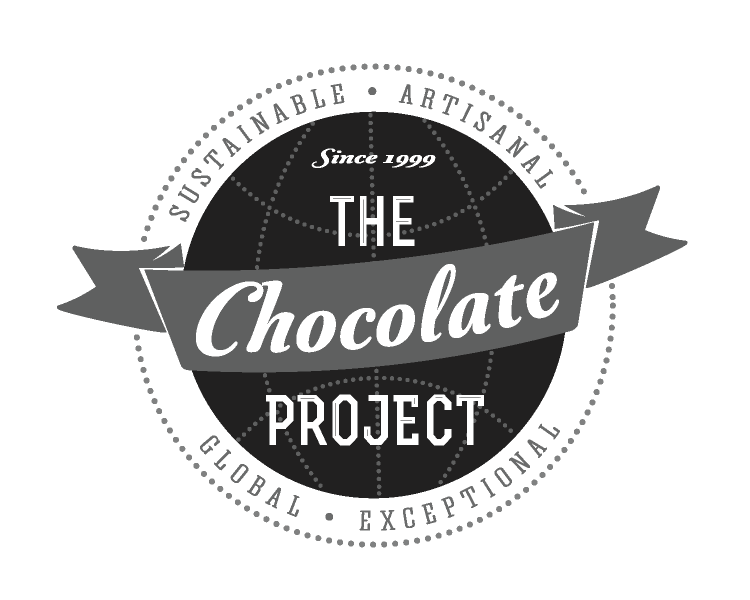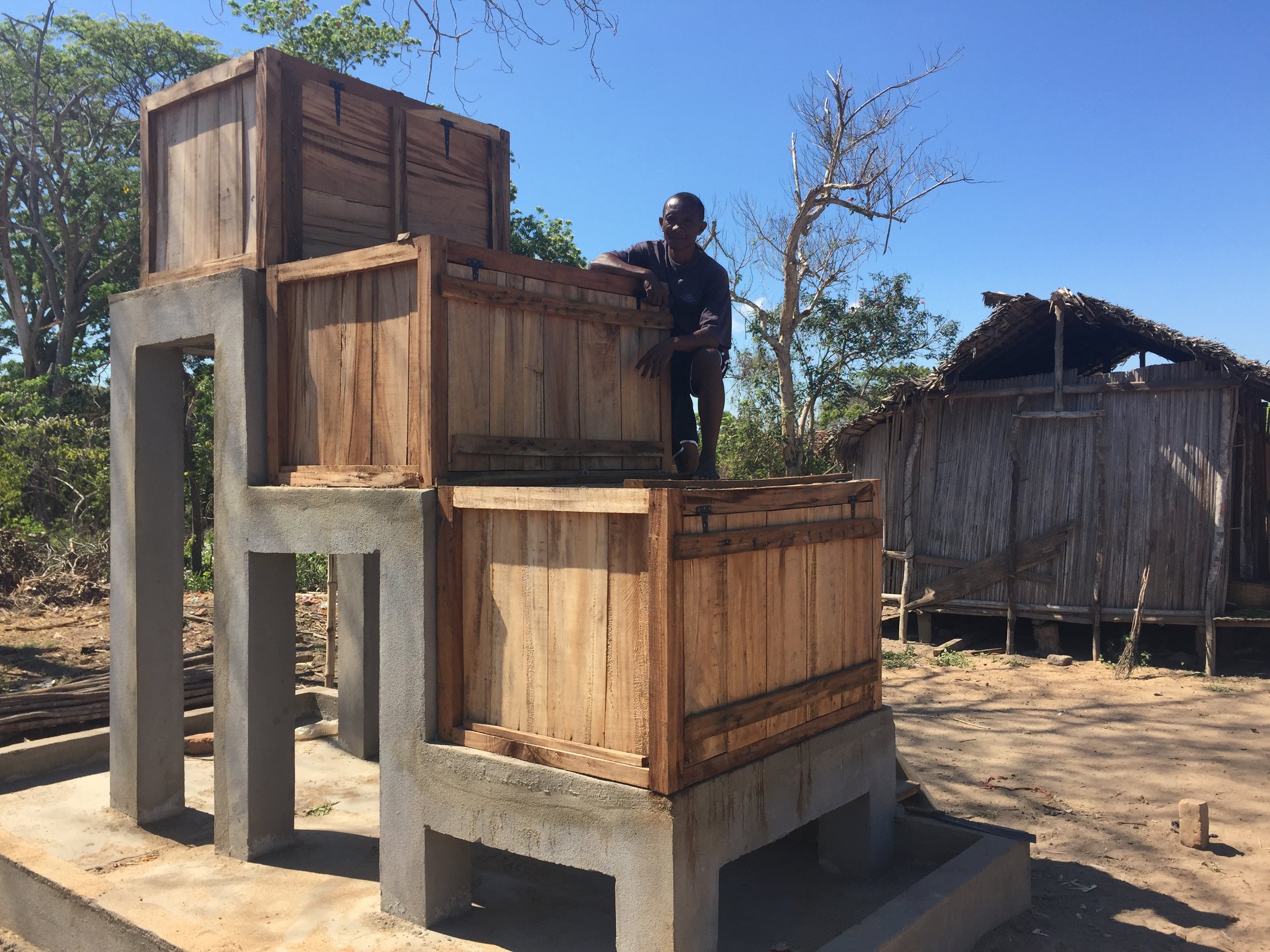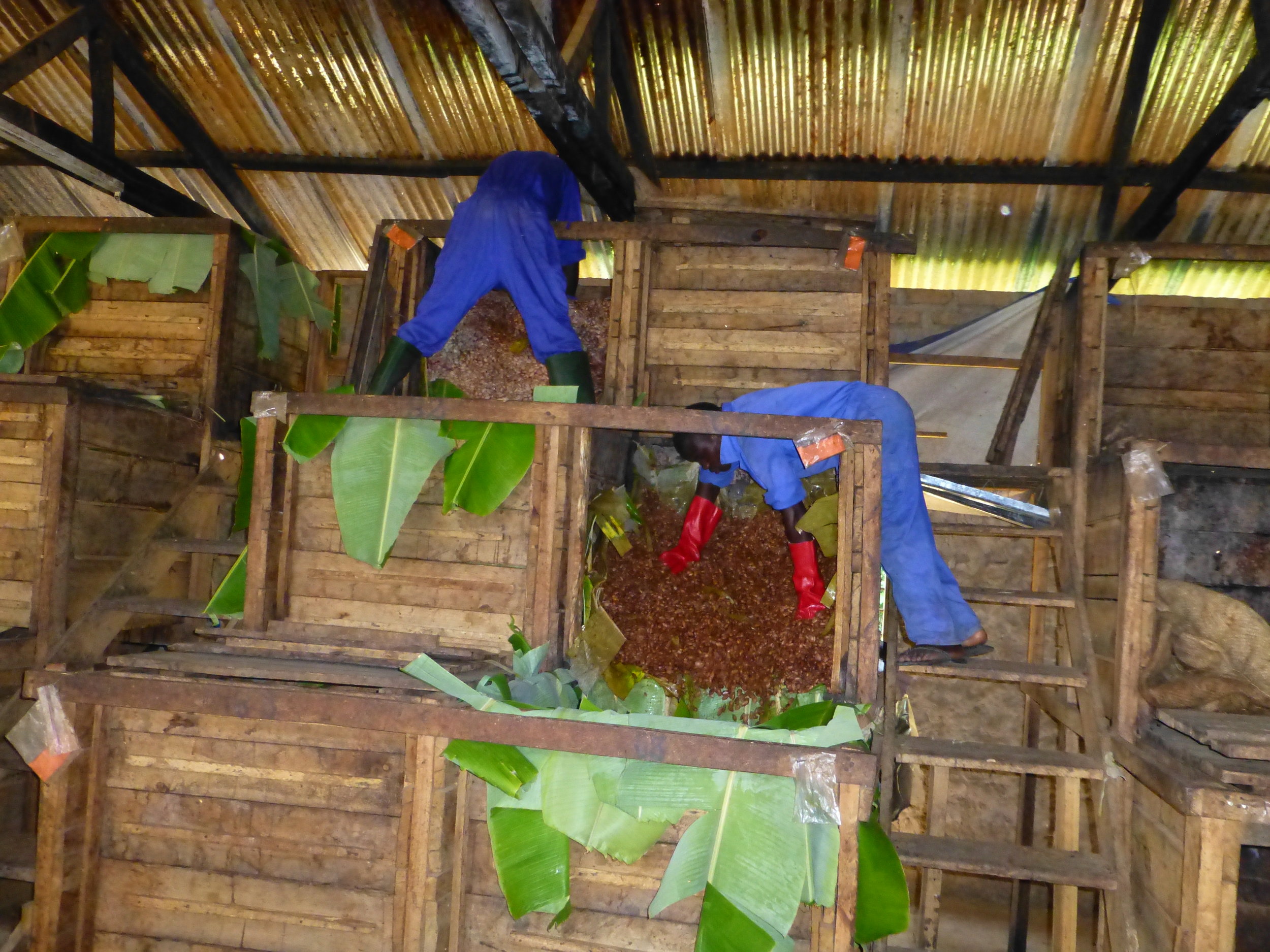The process for converting the fruit of the cacao tree into chocolate is a complex one. Fermenting the fruit pulp and seeds together is the first critical step and one that is not well understood by chocolate lovers. In today's blog we will take some basic steps toward explaining this remarkable transformation.
Soon after harvest, cacao pods are cracked open and the tasty, sticky, white pulp inside is removed. This pulp also contains the seeds, which at this point are somewhere between pale pink and pastel purple in colour. The pulp and seeds are placed into large wooden boxes, usually located not far from the harvest site. Most modern boxes average 4' square and will hold about a tonne of fruit each. Once filled, the seeds are covered with banana leaves and sometimes plastic sheeting. This helps to hold in the heat that is produced during fermentation and it is thought that the banana leaves contribute beneficial yeasts and microbial agents to the cacao fruit. Insect contact also certainly helps to introduce yeast into the box, as do the hands of harvesters as they scoop fruit out of the cacao husks. Before long, the sugars in the fruit pulp are beginning to break down and fermentation begins.
When we say cacao is "fermented" we are really talking about the white pulp not the seeds. The seeds go through a chemical transformation due to the fact that they are coated with fermenting pulp. First, fruit sugars are converted into alcohol. This initial fermentation relies on yeasts and occurs anaerobically within the box. It typically takes one to two days with the yeast population peaking at about the 24 hour mark. Holes in the bottom of the fermenting boxes allow excess liquid to seep away and a surprising amount of heat is produced. The internal temperature can reach 46C-50C by the second day. At this point the heat and concentration of alcohol kill the yeasts and the first stage is over.
Next, bacteria begin to convert the alcohol into acids (primarily acetic acid). This process requires oxygen so the box must be turned immediately to ensure that all the beans are evenly affected. Waiting too long to aerate the box, or aerating incompletely, can result in the growth of lactobacillus and the production of lactic acid which causes undesirable volatile notes in the finished cacao. Bacterial concentrations are highest at day three and then decline rapidly so most ferments take about five or six days in total.
When the bacterial ferment begins, important changes start to happen within the seed. During the first stage the seed is still alive but the combination of heat and alcohol eventually kill the "germ" or living portion of the seed that would have become a new tree. This seed death causes the breakdown of cellular walls and allows the acids from stage two to penetrate the seed. This has many beneficial effects. The pH of the seed is lowered, rendering it more acidic. Bitter elements in the raw seed are converted by enzymes into more palatable compounds. The colour of the seed changes from the pale pinky-purple to a rich brown. Most importantly, this process creates long and complex chemical chains, sometimes called "flavour precursors", within the seed. These are elements which we associate with the taste and aroma of fine chocolate but they are only developed through careful drying and roasting – the steps in the chocolate making process that come after fermentation. A well fermented bean still does not taste like chocolate but it now contains the building blocks to become chocolate.
It is interesting to consider that one of the most crucial steps in the creation of fine chocolate happens in the jungle in a very primitive fashion. It depends on random wild yeasts and bacteria overseen by foragers and farmers who are not chocolate makers. Much can, and does, go wrong.
Too short of a fermentation and your beans are tannic and bitter. Too long in the box can leave them open to spoilage bacteria and off flavours. Incomplete bacterial conversion can yield beans which are purple not brown inside and have undeveloped desirable flavour precursors. In many parts of the cacao growing world, it is traditional to ferment without a box at all – a pile of fruit pulp is heaped onto a mat of leaves on the jungle floor. More leaves are placed over top and the whole thing is left to cook. Not a recipe for quality.
Historically, industrial chocolate makers have paid little attention to fermentation: they can always mitigate a bad bag of beans by heavily roasting them, adding lots of extra sugar and blending them with thousands of other bags. Unfortunately, this meant that the farmers who sold to them didn't have to be too exacting either. Poor quality beans are still the norm in commercial chocolate but change is sweeping through many cacao growing regions thanks to the bean-to-bar chocolate renaissance. Another driving force is a growing consumer base who want to know exactly where their chocolate comes from and what makes it taste that way.
Today's craft chocolate makers are working with very small lots of beans (sometimes just one bag!). They are trying to preserve the unique characteristics of the cacao and not blend them away. Unfortunately, they have very little control over one of the most critical steps in the process. When a bag of beans arrives at the shop after a journey of thousands of miles one hopes for well fermented beans but doesn't always get them. This is all the more reason to encourage a very close working relationship and dialogue between farmer and chocolate maker. Many chocolate makers are actually going to the farm and overseeing the fermentation and drying of their beans in person. As a result of this information exchange we are now seeing farmers, who have learned to become very good fermenters, taking the next step and making their own chocolate bars!
Photos showing fermentation set-ups from cacao farms around the world. Photo credits (from top left):
1- Fermentation boxes in Madagascar (Madecasse Chocolate); 2- Colourful tubs of wet cacao ready to ferment with drying fermented cacao in the foreground in Madagascar (Madecasse Chocolate); 3- Fermentation boxes in Columbia (M. Beltran, Bosques de Cacao Yariguies) ; 4- Turning the fermenting cacao in Mexico (A. Madalinska, Agrofloresta); 5- Tiered fermentation boxes in Costa Rica (P. Robinson); 6- Quality Team member recording the temperature of the fermenting mass, in Tanzania (Kokoa Kamili); 7- Team members turning fermenting mass by moving it from upper box to lower box, in Tanzania (Kokoa Kamili); 8- Fermentation boxes in Tanzania (Kokoa Kamili); 9- Fermentation cut tests of cacao, in Mexico (A. Madalinska, Agrofloresta).









